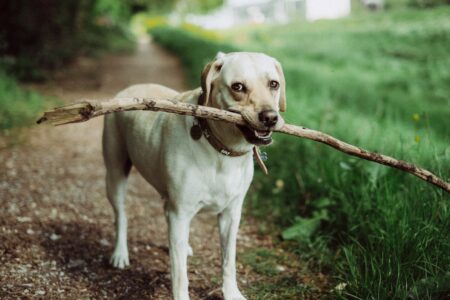My brown mutt and I went for a walk recently on an old railroad grade at the edge of a ghost-town where we sometimes stroll. Buster Brown is a Lab mix, with an emphasis on the mix.
Buster likes to visit the ghost-town in part because it still has one occupied house, and friends of mine live there with their chickens, a cat and a dog. The resident dog is a small, insanely intense cattle dog mix. He dedicates his considerable energies to retrieving pine cones kicked along the road by willing walkers.
While Buster is willing to retrieve sticks thrown into water, he would not play that game for more than 10 minutes. But I cannot tire out his country friend, who will chase pinecones as long as you are willing to kick them. The little cattle-dog has a deep and unshakable concentration for his self-assigned “work.”
Humans have bred that kind of intensity into some dogs. And science is now revealing that along with focused energy, some dogs have more intelligence than we ever really understood. Here is the story:
A border collie in South Carolina named “Chaser” was adopted by a research psychologist after the man retired and had free time. John W. Pilley took Chaser home when she was 8-weeks of age and started intensive, 5-hours per day training of the young pup. For three years the dog worked with Pilley and a few others, learning a variety of commands and behaviors through the process of game-playing, with nothing more than verbal praise as a reward for a job well done.
Only a border collie would love so much schooling, but Chaser flourished in her new life.
What is impressive is how much Pilley was able to teach the collie to ultimately do. Pilley acquired second-hand stuffed toys and went to work teaching Chaser to fetch individual toys by name. As the total number of toys Chaser knew edged into the hundreds, Pilley had to write their names on them with a marker so he could remember them all. In the end, Chaser learned over 1,000 proper names for the toys and could reliably fetch them from another room or a different part of the yard and bring them back to Pilley.
She also learned what you could term “group names.” For example, some of the toys were Frisbees, and some were cloth disks you throw in the same way. Chaser learned specific names for such toys, but also the general category “Frisbee.” This means she will fetch a “Frisbee” – whatever one may be available – if you ask her for a “Frisbee”. But she’ll also bring you one particular disk-toy if you ask for it by it’s specific name.
What is even more impressive is how Chaser responds to situations that might overwhelm a 4-year old human. Let’s say you put a new toy among the ones Chaser knows – a toy she has never seen before. Then you ask her to fetch and give her a specific name she’s never heard before. Chaser goes to her toys, looks them all over, and apparently thinks pretty deeply about her work. She then selects the toy she’s never seen and doesn’t know. This is called “learning by exclusion” and is the mark of some serious thinking in her furry noggin.
It is not clear that border collies really need to be so smart. The commands they follow for a shepherd rounding up sheep are not so complex as learning by exclusion, nor do the collies need to know thousands of individual sheep names. But, somehow, it seems that in the process of breeding border collies for their indefatigable willingness to work for us around the clock, we have created truly thinking canines.
One thing seems clear. Chaser looks awfully smart to us not because she was a really special border collie pup, but because she fell into an extremely rich learning environment.
Some would say my Buster Brown is not in the same mental league as Chaser. But if Buster could speak he might point out he gets his kibbles every day just like she does, and without slavish devotion to tiring work.
Which canine really is the smarter dog?







